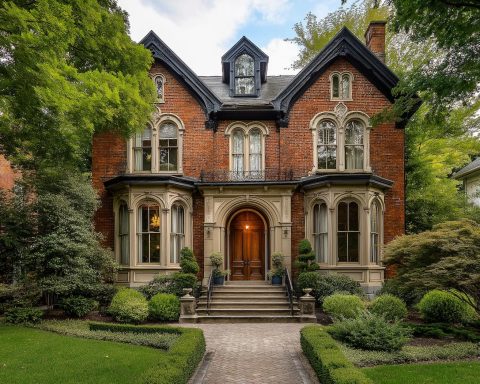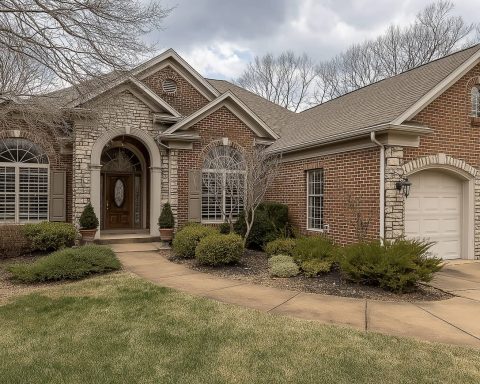- Fed rate cut triggers relief: The U.S. Federal Reserve’s widely-anticipated interest rate cut on Sept. 17 sent ripples through global property markets, immediately lowering mortgage costs in dollar-pegged countries like the UAE gulfnews.com. Homebuyers and investors worldwide braced for easier financing conditions.
- U.S. housing stuck in a rut: America’s housing market remains sluggish under ~6.5% mortgage rates, with home prices posting their first sustained declines since 2023 reuters.com. Analysts expect only about 2% price growth through 2026 – far below inflation – and a modest rebound by 2027 reuters.com. “Buying a home is going to be out of most young Americans’ reach for quite some time,” warned James Knightley of ING reuters.com.
- “Housing crisis” alarms in North America: U.S. officials are sounding alarms (Treasury officials even discussed declaring a national housing emergency reuters.com) as high housing costs squeeze buyers. Bond giant PIMCO urged the Fed to halt its mortgage-bond runoff to help drive 30-year loan rates down, noting “if the Fed continues its current approach, expect mortgage rates to remain elevated through 2026, making homeownership a luxury good reserved for the wealthy” reuters.com. In Canada, new Prime Minister Mark Carney declared “we’re in a housing crisis… it’s going to take all hands on deck to get us out of it” and unveiled a C$13 billion “Build Canada Homes” agency to spur affordable home construction reuters.com reuters.com.
- Europe’s markets find footing: In the UK and Germany, housing downturns are easing. British home prices are now forecast to rise just ~2.5%–3% annually in 2025–26 – slower than thought earlier reuters.com – which should improve first-time buyer affordability. “Strong wage growth is helping to narrow the affordability gap, while improvements in the mortgage landscape are sparking greater buyer interest,” said Marc Von Grundherr of London agency Benham & Reeves reuters.com. Germany’s property market is emerging from its deepest slump in decades thanks to European Central Bank rate cuts. Home values are projected to climb ~3% in 2025 (after falling two years) reuters.com. However, 11 of 14 experts warn affordability will worsen further as supply lags reuters.com. “Despite stagnating affordability… we do not see any indications of a reversal of [the housing] recovery”, noted Carsten Brzeski, ING’s global head of macro reuters.com, pointing to persistent housing demand.
- Asia: China’s prolonged slump vs. Japan’s deal spree: China’s property crisis deepened – August new home prices fell 0.3% from July and –2.5% year-on-year reuters.com despite dozens of easing measures. Sales and investment are still tumbling reuters.com. Beijing vowed “forceful” steps to stabilize housing, and major cities like Shanghai and Shenzhen loosened homebuying curbs reuters.com. But most analysts now don’t see prices bottoming until 2026 or 2027 reuters.com. As developers grapple with liquidity, a Hong Kong court appointed receivers to seize assets of Evergrande’s jailed founder Hui Ka Yan in an effort to claw back $6 billion in diverted funds reuters.com. Evergrande – once China’s top builder – is now formally insolvent with over $300 billion in liabilities reuters.com. Elsewhere in Asia, Japan’s real estate players are expanding overseas: Tokyo-based Seibu Prince Hotels agreed to buy U.S.-founded Ace Hotels for $90 million, aiming to “expand into more regions to accelerate our global expansion,” according to Seibu’s chairman costar.com.
- Middle East: Booming Gulf draws big capital: Property markets in the Middle East continued to surge. Dubai’s real estate values have soared ~70% over the past four years, fueled by foreign investment and visa reforms marketsgroup.org. In a sign of confidence, private equity giants Blackstone and Permira agreed to invest $525 million for a minority stake in Dubai’s Property Finder platform marketsgroup.org, allowing early investor General Atlantic to partially exit. It’s Permira’s first Middle East deal, coming just after it opened a Dubai office marketsgroup.org. Dubai is also launching new policies to sustain momentum – the city just introduced a First-Time Home Buyer scheme offering financial support (via the Dubai Land Department and local banks) to help UAE citizens purchase their first house timesofdubai.ae timesofdubai.ae. Meanwhile, Gulf monetary policy mirrored the Fed: the UAE Central Bank promptly matched the U.S. rate cut, instantly trimming mortgage rates for local homebuyers gulfnews.com. Banks expect a surge of end-of-year housing demand as cheaper loans make owning in Dubai and Abu Dhabi more attractive than renting gulfnews.com.
- Africa: Rates diverge as housing demand grows: Across Africa, housing markets are marked by strong demand but chronic affordability challenges. South Africa’s Reserve Bank has delivered four consecutive interest rate cuts since late 2024, bringing the prime rate down to 10.75% by mid-2025 ooba.co.za ooba.co.za. Lower financing costs have unlocked pent-up buyer activity, yet the nation still faces an acute 2.3 million unit housing shortage ooba.co.za that keeps prices and rents high. By contrast, Nigeria has been forced to keep interest rates elevated – its central bank stunned markets with a fifth rate hike to 27.25% in an effort to tame 32% inflation reuters.com reuters.com. Such sky-high rates make formal mortgages unattainable for many Nigerians, slowing formal real estate development. Even so, investors are eyeing opportunity: key cities like Cape Town, Nairobi and Lagos are seeing major growth in property values on the back of urbanization and new infrastructure rprealtyplus.com. Rental yields in Africa’s urban hubs remain attractive (often well above 8–10%), drawing interest from both local and foreign investors. Governments are also stepping in – Nigeria and Kenya have unveiled programs to boost housing credit and construction, aiming to tap rapid urban growth while avoiding slums.
- Latin America: High rates and housing initiatives: Brazil, Latin America’s largest economy, is walking a tightrope with real estate. After aggressive tightening, Brazil’s benchmark Selic rate sits around 14.75% – a near 20-year high reuters.com, which has dampened home sales and even caused a funding crunch for developers as Brazilians pull savings from low-yield bank accounts. The Central Bank of Brazil signaled a “bridge” financing plan to support housing credit reuters.com, working with state lender Caixa to find new funding channels as traditional savings-based mortgage pools dry up. (When rates are this high, Brazilians shift money into higher-yield bonds, leaving a void in housing finance reuters.com.) Market watchers expect Brazil to begin easing monetary policy soon to relieve pressure on its property sector. Mexico, meanwhile, is grappling with a housing affordability strain in its capital. Rents in Mexico City have surged in recent years as remote-working foreign “digital nomads” drive up demand in trendy districts, sparking a backlash from locals. City officials have responded with proposals to cap short-term rentals and are fast-tracking urban housing projects. A recent study urged Mexico to radically densify housing (3–4× current levels) to accommodate lower-income families, replacing sprawling single-family homes with mid-rise apartments reuters.com reuters.com. In positive news, Colombia’s social housing programs are providing a model in the region: Colombia’s government-backed developments have significantly expanded homeownership among low-income buyers, a template Mexico and others now seek to emulate reuters.com.
North America
United States – Cooling market tests policy: The U.S. real estate market is sending mixed signals. Housing affordability is near record lows as 30-year mortgage rates hover above 6.3%, roughly double pre-pandemic levels reuters.com. That spike in financing costs has pushed home prices into four consecutive months of decline for the first time since 2013 reuters.com, despite a modest easing of the listings crunch. Construction of new homes also remains tepid. High mortgage rates and soaring rents are exacerbating a long-standing U.S. housing shortage, Treasury Secretary Scott Bessent warned recently reuters.com. The country has 4.7 million fewer homes than needed by one estimate reuters.com, and a lack of affordable housing is now weighing on labor mobility and the broader economy. (In fact, many Americans feel “locked in” to their homes with ultra-low 3% pandemic-era mortgages, unwilling to move and face higher rates – a dynamic that stifles both housing supply and labor flexibility.)
Federal Reserve policymakers finally delivered a 0.25% interest rate cut in mid-September – their first easing in years – providing a glimmer of relief for would-be homebuyers and heavily indebted commercial property owners gulfnews.com. Markets expect further gradual cuts ahead. Yet mortgage spreads remain historically wide (over 230 basis points above Treasury yields) reuters.com, muting the impact of Fed moves on consumer rates. In a bold call, bond manager PIMCO urged the Fed to halt its ongoing runoff of mortgage-backed securities, arguing that reinvesting just ~$18 billion per month of MBS could trim mortgage rates by 20–30 basis points – equivalent to a full 1% rate cut in boosting housing affordability reuters.com reuters.com. PIMCO analysts noted this may be the Fed’s “most effective easing tool” now, given political constraints around rate policy reuters.com.
Meanwhile, the Biden-to-Trump administration transition (President Trump took office in January 2025) has brought a sharpened focus on housing. The new Treasury Secretary, Scott Bessent, signaled the federal government may declare a national housing emergency to unlock resources and preempt a broader economic drag reuters.com. “High mortgage rates and soaring rents…create a vicious negative spiral” by crimping consumer spending and job growth, Reuters noted in an analysis reuters.com reuters.com. The Trump administration has floated measures ranging from easing zoning rules to offering downpayment assistance for first-time buyers reuters.com (details forthcoming as of mid-September).
“With the labor market looking more strained, housing demand will remain soft… We could start to see some forced sellers if unemployment rises, and it may be that we get a bit of a house price correction over the next 6–12 months,” observed James Knightley, chief economist at ING reuters.com. He noted that even if prices dip, “buying a home is going to be out of most young Americans’ reach for quite some time.” Indeed, the median U.S. first-time buyer is now 38 years old – a record high, far above the late-20s age common in the 1980s reuters.com, underscoring how younger households have been squeezed out.
On the commercial side, the U.S. real estate market faces its own challenges. Office landlords in particular are confronting a “slow-burning crisis” as remote work reshapes demand. Nationwide office vacancy hit an unprecedented ~20.7% in Q2 reuters.com, according to Moody’s Analytics – a level unimaginable a few years ago. Major city centers like San Francisco (vacancy 27.7% reuters.com) and Manhattan’s downtown (~23%) are grappling with empty towers and plummeting valuations. Moody’s counts multiple recent fire sales of office buildings at 60%–97% discounts from their prior values reuters.com, crystallizing huge losses for owners and lenders. This threatens regional banks (many heavily exposed to commercial mortgages) and even city finances (as property tax bases erode) reuters.com. The silver lining: a “flight to quality” is underway, with the bulk of new leases happening in top-tier, amenity-rich buildings reuters.com, while aging offices languish. Investors like Carlyle are also hunting for bargains – Carlyle raised a record $9 billion U.S. real estate fund to deploy into residential, logistics and self-storage properties (avoiding offices and malls) reuters.com reuters.com, betting that “this is a compelling moment to invest” as valuations bottom out reuters.com.
Canada – Emergency measures and cooling starts: North of the border, Canada’s housing affordability has also deteriorated to crisis levels, sparking major policy intervention. In a striking development, new Prime Minister Mark Carney (the former Bank of England governor who became Liberal Party leader) announced the creation of Build Canada Homes, a federal housing accelerator agency capitalized with C$13 billion to kick-start construction reuters.com reuters.com. “We’re in a housing crisis… and it’s going to take all hands on deck,” Carney declared reuters.com, vowing to leverage public land and reduce developers’ upfront costs to boost supply reuters.com. The agency will directly build affordable units for low-income households and partner with private firms on middle-class housing reuters.com, targeting a dramatic increase in new home completions. This comes after Canada’s population surged (in part due to record immigration) without a commensurate increase in housing, sending rents and prices to all-time highs in cities like Toronto and Vancouver.
Early data show the scale of the challenge: Canadian housing starts plunged 16% in August from the prior month, far worse than expected reuters.com. The annualized pace fell to ~246,000 units – well below what experts say is needed to meet demand, and a sign that higher interest rates and construction costs are hampering builders. The Carney government has also signaled more relief for renters and a potential cap on foreign students (whose influx has stressed housing near universities). Notably, Canada’s approach is shifting from relying on monetary tools to more direct fiscal action on housing. This federal pivot comes after years of housing being primarily a provincial/municipal issue.
On the monetary front, the Bank of Canada held rates steady through mid-September, prioritizing inflation control, but pressure is building for rate cuts if the housing downturn drags on growth. The combination of record-high household debt and rising payments is squeezing Canadian consumers. Policymakers are navigating a delicate balancing act: cooling housing enough to improve affordability while avoiding a severe price crash that could imperil Canada’s financial system (where mortgages are heavily concentrated in a few big banks). The next 12–18 months will test whether Canada’s bold new supply-side measures can alleviate the housing crunch without a hard landing.
Europe
United Kingdom – Soft landing in sight? Britain’s housing market appears to be stabilizing after a mild correction, buoyed by falling mortgage rates and government support for first-time buyers. A Reuters poll of property analysts in early September found UK home prices will rise a modest 2.6% in 2025 (and ~3% annually in 2026–27) – significantly slower gains than expected just months ago reuters.com. This cooling is actually welcome news for policy makers and young buyers, as it eases the affordability crunch. Nearly 92% of experts polled said purchasing affordability for first-time buyers will improve in the coming year reuters.com. Driving that optimism is a combination of factors: wages are growing at their fastest pace in years, and the Bank of England has pivoted to rate cuts after a long tightening cycle, pulling average mortgage rates down from recent peaks reuters.com reuters.com.
One London estate agent, Marc Von Grundherr, noted that higher incomes plus cheaper loans are “sparking greater buyer interest and encouraging many who had been sitting on the fence to finally move into homeownership.” reuters.com Indeed, buyer inquiries have picked up in the late-summer months, according to survey data. However, the rebound is uneven: London’s prime market remains subdued, with prices in the capital expected to rise only ~1.9% this year reuters.com as foreign investors and wealthy locals pull back. “London has a ‘high end’ problem in that the current attack on wealth creators is not conducive to overseas buyers wanting to park their money here,” observed Russell Quirk of eMoov reuters.com, alluding to tax changes targeting luxury properties. Broadly, the UK’s outlook suggests a controlled cooling rather than a crash – helpful for buyers, though price levels (the average British home still costs 8× the average income) remain historically high reuters.com reuters.com.
On the policy front, housing is front and center as Britain heads toward a likely 2025 general election. The Conservative government’s controversial relaxation of some planning rules (to spur construction) has met local opposition in suburban areas. Meanwhile, the opposition Labour Party (leading in polls) is pledging a big boost to homebuilding and a tax on developers’ idle land. In the interim, the Bank of England’s rate cuts (125 bps of easing since mid-2024 reuters.com) have started to trickle through to lower borrowing costs. Markets expect another BoE trim next quarter as inflation abates reuters.com. However, fiscal challenges loom – a budget shortfall of £20 billion may force the Treasury (now led by Rachel Reeves) into tough choices, potentially even new housing taxes on the wealthy reuters.com reuters.com. Those prospects have some investors skittish about the luxury segment. For now, first-time buyers are getting a window of opportunity not seen in years – provided they can save for still-hefty deposits.
Germany – Tentative recovery amid headwinds: Europe’s largest economy is climbing out of a housing downturn, but it’s not out of the woods yet. After two years of falling home prices, German housing is poised to eke out a 3% price increase in 2025 reuters.com, according to a Reuters poll, marking the first annual gain since 2021. The rebound is fueled partly by the European Central Bank’s 200 bps of rate cuts (the ECB aggressively reversed course as Eurozone inflation cooled) reuters.com. Lower financing costs have improved buyer sentiment, and recent data showed home prices up 3.8% year-on-year in Q1 2025 – the fastest growth since 2022 reuters.com. Construction indicators are also turning up: building permits for new homes surged ~7.9% in June from a year earlier reuters.com, suggesting developers are responding to pent-up demand.
Yet German housing faces significant challenges. The broader economy slipped into a mild recession earlier this year, and high construction costs plus labor shortages are limiting new supply. Housing analysts caution that without stronger economic growth, any property recovery could falter. “The recovery continues, despite stagnating affordability… however, high uncertainty – economically and geopolitically – will likely continue to weigh on consumer confidence,” said Carsten Brzeski of ING reuters.com. Affordability for first-time buyers is actually expected to worsen in the coming year, 11 of 14 experts told Reuters reuters.com, due to still-elevated mortgage rates and rising home values. As in many countries, Germany’s younger households are struggling: wages haven’t kept up with the jump in housing costs seen during 2020–2022.
Berlin policymakers are responding with both new regulations and incentives. The government plans to extend rent controls to tame rent inflation in cities reuters.com – a popular move for tenants, though investors warn it could deter rental housing development. At the same time, Berlin is expanding subsidies for energy-efficient renovations and cutting VAT on new residential construction to help builders. Germany’s unique housing structure (a majority of residents rent, and big institutions play a growing role as landlords) means any recovery will look different than the Anglo-American housing cycles. Rents are forecast to keep rising 3–5% next year despite the rent cap extension reuters.com, reflecting a persistent supply-demand imbalance. Sebastian Wunsch of GEWOS noted that with building permits for rental housing still very low, there is “no foreseeable substantial improvement in affordability” on the horizon reuters.com. In short, Germany’s housing market is cautiously on the mend, but it faces a long road to solve its structural shortages.
Elsewhere in Europe: Markets across the continent present a mixed picture. France has seen transactions slow sharply as credit conditions tightened, though prices remain relatively flat (Paris is down only slightly). Spain and Portugal continue to attract significant foreign buying – particularly from digital nomads and Golden Visa seekers – which is sustaining price growth near 5% annually, much to locals’ frustration. Sweden and the Nordics, which experienced sharp price corrections in 2022–23 due to variable-rate mortgages, have stabilized and even ticked up as Nordic central banks signaled an end to rate hikes. However, Europe’s commercial real estate sector remains in a funk. Investment volumes across the EU fell to near-decade lows this year reuters.com, with office and retail property values under heavy pressure. A senior PGIM executive, Sebastiano Ferrante, described European property as “zombieland… no recovery, stranded assets, no liquidity” for now reuters.com. Private equity funds are circling distressed opportunities, but banks have largely adopted “extend and pretend” tactics to avoid crystalizing losses reuters.com. Observers say a true turning point may require further price capitulation by sellers and perhaps regulatory intervention to clear the logjam of troubled assets in markets like Germany and the UK. For the moment, Europe’s real estate story is one of cautious optimism on the residential side, and unresolved stress on the commercial front.
Asia
China – Pain deepens, policy support ramps up: China’s once-highflying property sector continues to struggle through a protracted bust. New home prices fell in August for a fourth straight month, down 0.3% from July and –2.5% year-on-year reuters.com across 70 major cities. Buyer sentiment remains moribund despite authorities rolling out wave after wave of stimulus. Since late August, dozens of cities have slashed down-payment requirements and mortgage rates for first-time buyers. Tier-1 metropolises Shanghai and Shenzhen even lifted homebuying restrictions in many districts reuters.com – a significant reversal of earlier curbs. The central government is signaling more forceful action: Premier Li Qiang in August ordered officials to “adopt forceful measures to consolidate the stabilizing trend” in real estate and stimulate housing demand reuters.com. There is speculation that the People’s Bank of China will cut the benchmark Loan Prime Rate imminently (watch for the Sept. 20 LPR decision) reuters.com.
So far, however, these measures have only arrested the decline, not sparked a rebound. Property sales by floor area are still down ~5% this year reuters.com, and property investment plunged 12.9% y/y in January–August reuters.com as developers halt new projects. Weak income growth, high youth unemployment, and a glut of unsold homes in smaller cities have created a vicious cycle of pessimism reuters.com. Most analysts in a Reuters poll now don’t expect China’s home prices to bottom until H2 2026 or 2027 reuters.com – roughly half a year later than they thought just three months ago. The impact of the property slump on China’s overall economy is stark: the sector (including construction) historically contributed up to 25–30% of GDP when you include indirect effects. That share has shrunk markedly. Steel demand and commodities tied to construction are weak; iron ore prices recently dipped in response to the ongoing real estate woes reuters.com.
The developer debt crisis also grinds on. Evergrande Group – whose 2021 default triggered the broader turmoil – has entered liquidation and was delisted from the Hong Kong stock exchange last month reuters.com. In a new twist, a Hong Kong judge this week appointed Evergrande’s court-approved liquidators as receivers over the personal assets of founder Hui Ka Yan reuters.com. Hui, once Asia’s second-richest man, vanished from public view after being detained by Chinese authorities in 2023. He also failed to comply with a court order to disclose his overseas assets reuters.com. The receivers will hunt to recover roughly $6 billion in allegedly misappropriated funds (dividends, etc.) from Hui and ex-executives reuters.com, as Evergrande’s creditors seek any salvage value. Another giant, Country Garden, narrowly averted default on a Ringgit bond last week and is negotiating a restructuring of its $11 billion offshore debt after defaulting on dollar bonds in 2023 reuters.com reuters.com. The company won support from 77% of its bondholders for a plan to slash its debt by 78% reuters.com, and a crucial court hearing on its liquidation is set for January 2026 reuters.com. Collectively, Chinese developers remain in survival mode – halting land buys, selling assets, and trying to deliver pre-sold homes to avoid social unrest.
Zhang Dawei, analyst at Centaline in Beijing, cautioned that “the real estate market is likely to face significant adjustment pressure in the near term” and is “anticipating stronger measures to stabilize the housing sector, including easing home purchase restrictions, looser credit policies, and… a potential interest rate cut on the LPR on September 20.” reuters.com Despite the gloom, Beijing’s resolve to prop up housing is clear – additional interest rate cuts, subsidies, or even a bailout fund for unfinished projects could emerge if conditions deteriorate further.
Outside China, Asia’s other property markets present a mixed landscape:
- Japan: The commercial real estate scene in Japan is relatively stable, with J-REITs (real estate investment trusts) attracting capital thanks to ultra-low interest rates. Notably, Japanese investors are looking outward for growth. In a headline cross-border deal, Seibu Prince Hotels announced it will acquire the U.S.-based Ace Hotel chain for $90 million costar.com. The move gives Seibu a trendy boutique brand and foothold in global gateway cities (Ace has properties from New York to Kyoto). “By leveraging the strengths of each side, we will expand into more regions to accelerate our global expansion,” said Seibu Holdings Chairman Takashi Goto at a press conference in Tokyo costar.com. This reflects a broader trend of cash-rich Asian firms bargain-hunting overseas assets. Domestically, Japan’s housing market remains supported by cheap mortgages (the Bank of Japan has yet to hike rates) and steady demand in Tokyo, though the specter of an aging population and surplus rural homes looms in the longer term.
- India: India’s residential market is showing resilience, with housing sales in major cities up by double digits year-on-year as of Q3 2025. Low interest rates (the Reserve Bank of India paused hikes) and a booming IT sector have boosted middle-class homebuying. Developers, however, face margin pressures from higher input costs. The Indian government is advancing a $60 billion urban infrastructure push – including metro rail and smart city projects – which is expected to unlock new corridors for real estate development. Foreign investors are increasingly active in Indian commercial real estate, especially in logistics/warehousing and data center facilities in Mumbai, Bengaluru, and NCR.
- Southeast Asia: In Singapore, private home prices have plateaued after years of sharp gains, as the government’s cooling measures (higher stamp duties for foreigners, tighter loan limits) took effect. Malaysia and Thailand are courting Chinese homebuyers who have soured on their domestic market; both countries have seen a notable uptick in inquiries from mainland investors. Vietnam is dealing with its own developer debt problems – the government has intervened to restructure debts of big realty firms and cut mortgage rates to prevent a bust. Indonesia is benefiting from a commodities boom, which has fueled property demand in Jakarta for high-end residences and in Bali for villas (as digital nomads flock in under new long-stay visas).
In summary, Asia’s real estate picture ranges from China’s deep housing malaise to brighter spots in emerging markets and opportunistic outbound investment. The next few months will be critical to watch: China’s policy measures and any sign of stabilization there could lift sentiment across the region, while further distress could pose risks to banks and commodities linked to real estate.
Middle East
Gulf Region – Red-hot markets and new policies: The Middle East’s real estate powerhouse markets – especially the Gulf states – continued their remarkable post-pandemic surge through September. Dubai, UAE stands out with record-breaking momentum. Property prices in Dubai are up roughly 70% since 2019 marketsgroup.org, thanks to an influx of foreign buyers (from crypto millionaires to wealthy Russians and Indians), business-friendly reforms, and the UAE’s successful handling of COVID-19 which made it a safe investment haven. August data showed Dubai home prices ~20% higher year-on-year, with particular strength in luxury villas. This boom is drawing in major global investors: private equity firms Permira and Blackstone just agreed to acquire a $525 million stake in Dubai’s leading real estate portal, Property Finder marketsgroup.org. The deal marks Permira’s first investment in the Middle East – the firm even opened a new Dubai office – and represents a partial exit for General Atlantic (which invested in 2018) marketsgroup.org. Property Finder’s expanded war chest will help it grow across MENA at a time when digital real estate listings are increasingly vital to market transparency.
Dubai’s government, keen to sustain the property rally yet avoid a bubble, has introduced targeted measures. On Sept. 16, authorities launched a First-Time Home Buyer programme aimed at UAE nationals in Dubai timesofdubai.ae. Under this scheme, eligible Emirati first-time buyers receive financial support and fast-track approvals for mortgages, with the Dubai Land Department partnering with banks to offer reduced interest rates, fee waivers, and flexible payment plans timesofdubai.ae. The goal is to convert more long-term residents from renters to owners and ensure locals aren’t left behind in a market driven by foreign capital. Additionally, the UAE Central Bank moved in lockstep with the U.S. Fed’s September rate cut – since the dirham is pegged to the dollar, the UAE immediately trimmed its base rates by 25 bps. This “mortgage relief” is set to lower UAE home loan costs overnight gulfnews.com. Homebuyers, tenants-turned-buyers, and property investors in the Emirates are all expected to benefit from the cheaper financing gulfnews.com gulfnews.com. Lenders are already reporting a jump in inquiries about refinancing existing loans and new buyers qualifying for larger mortgages, now that the Fed’s tightening cycle has reversed.
Elsewhere in the Gulf, Saudi Arabia is pressing ahead with its giga-projects (like NEOM city and Red Sea resorts) which are part real estate play, part economic diversification. While Riyadh’s ultra-modern projects grab headlines, the kingdom’s domestic housing push is also significant: the Saudi government’s Sakani program continues to subsidize home purchases for citizens, and mortgage volumes are at record highs (albeit starting to plateau as rates had risen). Qatar and Bahrain have seen quieter markets, but Qatar expects a post-World Cup cooling to be temporary, with preparations for the 2030 Asian Games set to spur another construction cycle.
One cloud on the horizon: analysts warn that Dubai’s property cycle may be near its peak. Fitch Ratings just cautioned that price growth is likely to slow sharply and could even turn into “double-digit declines” by late 2025 as a wave of new supply hits the market and global conditions tighten marketsgroup.org. Dubai has over 50,000 units under construction slated for delivery in the next 2 years, which could test demand. However, for now, demand remains robust – September’s off-plan (new development) sales in Dubai hit their highest in over a decade, indicating investors are still optimistic. Real estate capital flows into the Middle East are also rising, with sovereign wealth funds (like Abu Dhabi’s ADIA and Saudi’s PIF) investing heavily in logistics, data centers, and overseas property (PIF recently announced a $700 million investment in Indian housing, for example).
Middle East Commercial & North Africa: In the broader MENA region, Egypt’s real estate market is navigating a currency devaluation and high inflation – property is seen as a hedge by locals, boosting demand for apartments in Cairo despite economic turmoil. The Cairo government is selling stakes in state-owned realty firms to raise dollars and inviting Gulf investors to fund its New Administrative Capital. In North Africa, Morocco’s housing sector was dealt an unexpected blow by the tragic earthquake in early September, which destroyed thousands of homes around Marrakech. Reconstruction efforts, backed by government grants and donor aid, are set to become a major focus, likely leading to a short-term surge in building activity and possibly higher construction costs nationwide.
Overall, the Middle East’s real estate narrative in late 2025 is one of strong investor appetite (both local and foreign), governments leveraging policy to guide growth, and a watchful eye on global financial conditions. If U.S. rate cuts continue and oil prices remain healthy, the region’s property markets could extend their upswing – albeit at a moderated pace to ensure long-term sustainability.
Africa
Housing demand vs. affordability: Across Africa, rapid urbanization is creating immense demand for housing and commercial space, but economic challenges and high financing costs constrain supply. African cities are increasingly seen as attractive property investment hubs – recent analysis highlights major growth in real estate values in cities like Cape Town, Nairobi, and Lagos rprealtyplus.com. These urban centers benefit from growing middle classes, infrastructure developments, and, in some cases, foreign investment and tourism (Cape Town, for instance, draws international buyers for luxury real estate, while Nairobi has become a regional HQ for multinationals, boosting office and retail demand). However, the gap between demand and what local markets can supply affordably is vast.
South Africa – Easing cycle boosts prospects: South Africa’s property market is in the early stages of an upswing thanks to a turn in the interest rate cycle. After suffering from a decade-high prime lending rate of 11.75% in 2023, the South African Reserve Bank cut rates four times, bringing prime down to 10.75% by May 2025 ooba.co.za ooba.co.za. These 100 bps of cuts – made possible by inflation dipping below 3% – mark South Africa’s most significant monetary easing in years. Lower rates have translated into meaningfully reduced bond (mortgage) payments. Banks report a rise in home loan applications, and first-time buyers now make up nearly 47% of new mortgages – a multi-year high as more young South Africans find monthly payments within reach ooba.co.za. Property brokers are noting especially strong activity in affordable segments and “semigration” hotspots (coastal towns and smaller cities attracting remote workers). Nevertheless, South Africa faces a housing shortage of roughly 2.3 million units ooba.co.za, mainly affecting lower-income households. Major cities like Johannesburg and Durban have vast informal settlements. The government’s efforts to boost housing (including social housing projects and subsidies) are ongoing, but progress is slow. Construction of entry-level homes has been sluggish due to budget constraints and capacity issues. The upside is that rental demand remains robust – areas with undersupply of rentals (e.g., Cape Town’s city bowl and some suburbs) are seeing increased yields, making buy-to-let investment attractive in this low-rate environment ooba.co.za. Commercial real estate in South Africa is mixed: top-grade office and industrial properties yield around 8–10%, enticing some investors, but older office buildings struggle with high vacancy as companies downsize space. The retail sector is resilient (shopping malls still draw crowds), though load-shedding (power outages) add costs for property managers who must secure backup power.
Nigeria – High rates and hopeful reforms: Nigeria, Africa’s most populous nation, illustrates the housing finance conundrum. To combat persistent inflation (which, after peaking above 24%, eased slightly to ~21–22% mid-year), the Central Bank of Nigeria jacked up its benchmark interest rate to 27.25% – the fifth hike in 2024 alone, and the highest in decades reuters.com. This has kept mortgages firmly out of reach for most Nigerians – with double-digit inflation and lending rates often 25–30%, only the wealthy or diaspora Nigerians can afford home loans. As a result, an estimated 90% of Nigeria’s housing is funded out-of-pocket (incrementally building homes over years), and the country faces a housing deficit of over 20 million units. The new government under President Bola Tinubu is attempting sweeping economic reforms: it removed costly fuel subsidies and is working to unify the exchange rate. In housing, authorities plan to float a ₦200 billion (~$260 million) mortgage bond (with partial government guarantees) to inject liquidity into the housing market reuters.com. They are also exploring Public-Private Partnerships to develop affordable homes. Lagos, Nigeria’s commercial capital, is seeing a construction boom in upscale apartments and mixed-use towers funded by private developers and local pension funds – but these cater mostly to high-income earners and expatriates. Affordable housing projects, such as the government’s mass housing schemes in Abuja and new satellite towns, often stall or deliver units that are still too expensive for average families.
Elsewhere in sub-Saharan Africa, Kenya’s Nairobi continues to be a real estate bright spot. The city has a vibrant housing market, with new suburbs and estates spreading outwards. The Kenyan government recently enacted an affordable housing levy to fund new low-cost homes, aiming to build 200,000 units a year (a goal not yet met). Ghana and Ivory Coast are also innovating with housing funds and diaspora bonds to finance development. In North Africa, Egypt (though economically strained) is pushing ahead with its New Capital City project and other developments, betting on real estate as an economic driver and hedge against currency devaluation.
Razia Khan, chief economist for Africa at Standard Chartered, has noted that in some African markets, “core inflation remains elevated… the policy rate is still negative [in real terms],” suggesting that high nominal rates have not fully tamed inflation reuters.com reuters.com. In other words, many African central banks face a dilemma: cutting rates could spur real estate and construction, but risks reigniting price instability. Bismarck Rewane, CEO of Financial Derivatives Co. in Lagos, praised Nigeria’s most recent rate hike as “bold and audacious… it might stabilize the naira a bit. But definitely the cost of borrowing is going to be higher.” reuters.com That trade-off – stability vs. growth – is at the heart of Africa’s real estate financing challenges.
Looking ahead, Africa’s youthful demographics and urban growth are fundamentally bullish for real estate demand. The World Bank projects Africa’s cities will add 950 million residents by 2050. This represents vast need – and opportunity – for housing, offices, roads, and malls. The key will be mobilizing financing (both domestic and foreign) at scale and making construction more efficient and affordable. Some encouraging signs include rising interest from institutional investors (e.g., South African REITs expanding into the continent) and technology-driven cost reductions (such as modular housing and 3D-printed homes piloted in Kenya). If inflation can be reined in and political stability maintained, Africa could see a construction boom in the coming decades unlike any other.
Latin America
Brazil – Bridging a funding gap: Brazil’s property market finds itself at an inflection point amid shifting economic winds. For several years, high interest rates (Selic at 14.75%) and double-digit inflation kept housing activity subdued reuters.com. The central bank’s aggressive tightening – aimed at protecting the currency and curbing price spikes – made Brazil’s mortgage rates some of the most expensive globally, drastically limiting credit-fueled homebuying. Most Brazilians either rent or purchase homes with significant savings/down payments due to these financing hurdles. Compounding the issue, Brazil’s unique housing finance system relies heavily on savings accounts (the FGTS and SBPE funds) which have seen outflows as savers chase higher yields elsewhere reuters.com. By mid-year, balances in those savings schemes were down in both nominal and real terms reuters.com, prompting concerns of a credit crunch for builders.
Sensing the urgency, Central Bank Governor Gabriel Galipolo announced work on a “bridge solution” to ensure real estate projects don’t starve for funding reuters.com. The plan involves transitioning from the old model to new alternative funding sources – possibly greater securitization of mortgages, involvement of institutional investors like insurers/pension funds, or even temporary central bank liquidity support to housing lenders. Galipolo has been in talks with major stakeholders including state-owned Caixa Econômica Federal, Brazil’s largest housing lender, to coordinate this effort reuters.com. The political backdrop is that President Lula’s administration sees housing construction as key to jobs and social well-being (recall the popular “Minha Casa, Minha Vida” housing program from Lula’s earlier term, which has been revived). Indeed, the government recently boosted subsidies and relaunched low-income housing programs aiming to deliver 2 million affordable homes by 2026.
Economically, there are signs Brazil’s fortunes are improving: inflation has cooled from 12% in 2022 to around 5% now, allowing the central bank to start cutting the Selic rate (a 50 bps cut in August 2025) with more cuts likely by year-end. This should gradually reduce mortgage rates and stimulate housing demand. In anticipation, homebuilders’ stock prices have rallied in São Paulo trading, and real estate brokers report higher foot traffic at new project launches. Data from the Rio and São Paulo markets show price growth turning positive again in 2025 after a few flat years – though gains are modest (~3–5% y/y) and mostly in middle-class segments. High-end luxury properties in Brazil’s big cities are actually attracting foreign buyers taking advantage of the weak Brazilian real (wealthy Argentines and Europeans find Rio beachfront condos “cheap” in dollar terms).
Mexico – Battling an affordability squeeze: Mexico’s real estate market is witnessing divergent trends. On one hand, industrial real estate is booming – Northern Mexico, especially Monterrey and border states, has a hot demand for warehouses and factories thanks to “nearshoring” (as U.S.-China tensions push manufacturers to Mexico). On the other hand, residential housing in Mexico City and other major metros is facing an affordability crisis. The pandemic era saw a flood of remote workers from the U.S. and Europe relocate to Mexico City’s trendy neighborhoods (Condesa, Roma, Polanco), driving up rents and property values in those enclaves. Rents in some areas jumped 20–30% in two years, pricing out many locals. This gentrification wave sparked protests and calls for regulation; the city government is exploring limits on short-term rentals like Airbnb and incentives for landlords to offer longer leases at stable rents.
Local authorities have also ramped up housing supply initiatives. Mexico City’s mayor announced plans to convert underutilized office buildings in the downtown core into apartments – a move to both address a glut of vacant offices (post-COVID) and add housing units. Nationwide, a new urban development policy emphasizes densification: a recent study by MIT’s Albert Saiz argued Mexico must build upward – 3-4x denser – to house its lower-income population adequately reuters.com, because sprawl and self-built housing are not sustainable. Currently, over 60% of new Mexican homes are informal/self-built without developer or government oversight reuters.com, often resulting in substandard quality and poor access to services. The federal government under President Andrés Manuel López Obrador (AMLO) had focused housing support on a few social groups (like handing out some zero-interest loans to unionized workers), but critics say it wasn’t enough. The pressure is on the next administration (Mexico has a presidential election in 2024) to expand housing programs for the neediest 20% of the population reuters.com.
Mexico’s central bank, Banxico, has kept its policy rate around 11.25%, one of the highest among major economies, as of September – inflation has eased, but only gradually. The high rates have kept a lid on mortgage growth, but also stabilized the peso. Interestingly, Mexico’s home price index has still grown ~7% year-on-year (as of Q2) because housing demand outstrips supply in many cities and a lot of transactions are cash-based or employer-financed through INFONAVIT (a worker housing fund). If Banxico starts cutting rates in 2026, as markets predict reuters.com, it could unleash a new wave of homebuyer demand – making the task of boosting supply even more urgent.
Andes and beyond: In Chile, a long period of low rates and stable growth had fueled a housing boom, but recent rate hikes and a sluggish economy cooled the market. Now, Chile’s central bank is one of the first in LatAm to aggressively cut rates (a 75 bps cut in July) as inflation falls – mortgage rates are correspondingly dipping, which may reinvigorate sales late in 2025. Colombia has had success with social housing: its “Mi Casa Ya” program has helped hundreds of thousands of families buy homes with government subsidies. That helped Colombia’s housing market stay resilient even during rate hikes. In Argentina, high inflation (120%+) and currency instability have practically frozen the formal real estate market – most sales are done in cash USD, and prices in Buenos Aires have dropped in dollar terms. Many developers are on hold awaiting the outcome of upcoming elections and potential economic reforms.
Latin America’s real estate outlook is thus highly country-specific, but common themes include the need for more affordable housing, the impact of high interest rates (now gradually reversing), and innovative approaches to financing.
Mark Carney, Canada’s new PM (and former central banker), perhaps best summed up the broader challenge in a North American context: “Housing is the largest contributor to the rising cost of living… We need big and broad action focused on boosting supply and helping more people into homes.” reuters.com reuters.com This sentiment resonates across many Latin American cities as well, where the dream of homeownership or even adequate housing is increasingly out of reach for the working class. The coming year will test how effectively policymakers and markets can respond to that imperative.
Sources:
- Reuters (Sarupya Ganguly), “US housing market to remain stuck in a rut as high rates choke demand”, Sept. 16, 2025 reuters.com reuters.com
- Reuters (Jamie McGeever), “US economy braces for twin housing, labor market headwinds”, Sept. 16, 2025 reuters.com reuters.com
- Reuters (Matt Tracy), “PIMCO recommends Fed halt mortgage unwind to boost housing market”, Sept. 16, 2025 reuters.com reuters.com
- Reuters (Fergal Smith), “Canadian housing starts fall 16% in August – CMHC”, Sept. 16, 2025 reuters.com
- Reuters (Mark Carney announcement via Reuters), “Canada announces new federal agency to build affordable housing”, Sept. 14, 2025 reuters.com reuters.com
- Reuters (Jonathan Cable), “UK house prices to rise more slowly than expected, helping first-time buyers: Reuters poll”, Sept. 16, 2025 reuters.com reuters.com
- Reuters (Indradip Ghosh), “German home prices set for steady recovery…, affordability to worsen”, Sept. 16, 2025 reuters.com reuters.com
- Reuters (Liangping Gao et al.), “China’s home prices extend decline, more policy support needed”, Sept. 15, 2025 reuters.com reuters.com
- Reuters (Clare Jim), “China Evergrande liquidators appointed as receivers over founder’s assets”, Sept. 16, 2025 reuters.com reuters.com
- Reuters (Rishav Chatterjee), “Country Garden wins bank creditor group’s support for offshore debt overhaul”, Aug. 18, 2025 reuters.com reuters.com
- CoStar News (Trevor Simpson), “5 things to know for Sept. 16, 2025” – Seibu Prince Hotels deal, Sept. 16, 2025 costar.com
- Markets Group / Reuters source, “Permira, Blackstone invest $525M in Dubai’s Property Finder”, Sept. 9, 2025 marketsgroup.org marketsgroup.org
- Times of Dubai (Khwaish Manwani), “First-time Home Buyer scheme in Dubai: What One Needs to Know”, Sept. 16, 2025 timesofdubai.ae timesofdubai.ae
- Gulf News (Justin Varghese), “UAE homes set to get cheaper as rate cut slashes mortgage costs”, Sept. 16, 2025 gulfnews.com gulfnews.com
- Reuters (Iain Withers et al.), “European real estate stuck in ‘zombieland’ as recovery proves elusive”, July 17, 2025 reuters.com reuters.com
- Reuters (Isla Binnie), “Carlyle raises $9 billion for US real estate bets”, Aug. 4, 2025 reuters.com reuters.com
- Reuters (Devayani Sathyan), “Aussie home prices to rise on interest rate cuts…: Reuters poll”, Sept. 10, 2025 reuters.com reuters.com
- Reuters (Samuel McKeith), “Australia to put two-year ban on foreigners buying existing homes…”, Feb. 16, 2025 reuters.com reuters.com
- Reuters (Elisha Bala-Gbogbo), “Nigeria’s central bank surprises with fifth rate hike this year”, Sept. 24, 2024 reuters.com reuters.com
- Realty+ Magazine, “African Cities Take-off as Attractive Property Investment Hubs”, July 21, 2025 rprealtyplus.com
- Reuters (Kylie Madry), “Mexican housing must become denser, better planned – study”, Sept. 1, 2022 reuters.com reuters.com










